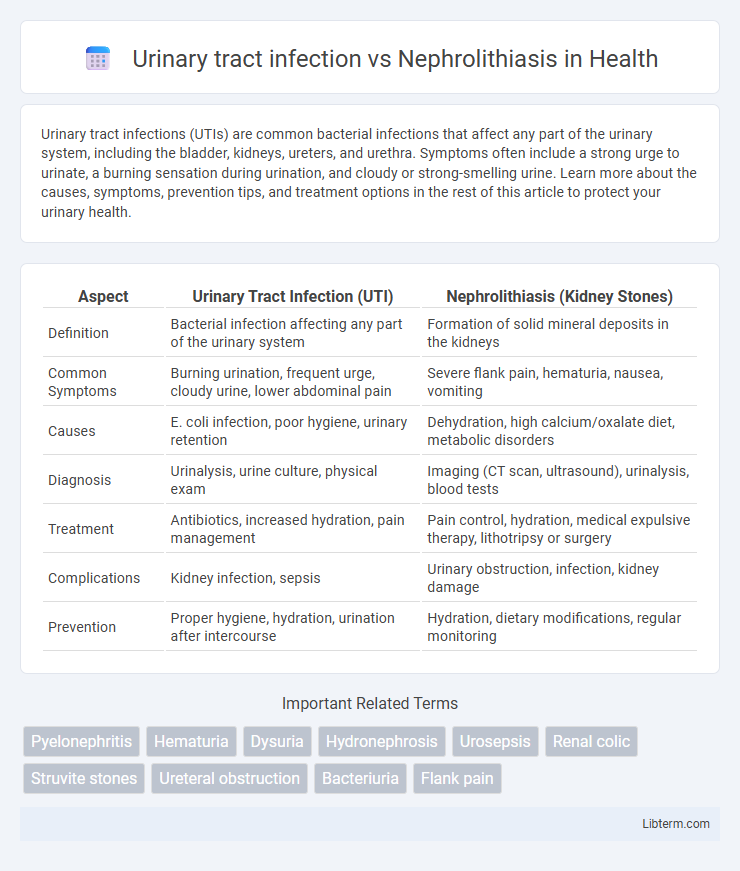Urinary tract infections (UTIs) are common bacterial infections that affect any part of the urinary system, including the bladder, kidneys, ureters, and urethra. Symptoms often include a strong urge to urinate, a burning sensation during urination, and cloudy or strong-smelling urine. Learn more about the causes, symptoms, prevention tips, and treatment options in the rest of this article to protect your urinary health.
Table of Comparison
| Aspect | Urinary Tract Infection (UTI) | Nephrolithiasis (Kidney Stones) |
|---|---|---|
| Definition | Bacterial infection affecting any part of the urinary system | Formation of solid mineral deposits in the kidneys |
| Common Symptoms | Burning urination, frequent urge, cloudy urine, lower abdominal pain | Severe flank pain, hematuria, nausea, vomiting |
| Causes | E. coli infection, poor hygiene, urinary retention | Dehydration, high calcium/oxalate diet, metabolic disorders |
| Diagnosis | Urinalysis, urine culture, physical exam | Imaging (CT scan, ultrasound), urinalysis, blood tests |
| Treatment | Antibiotics, increased hydration, pain management | Pain control, hydration, medical expulsive therapy, lithotripsy or surgery |
| Complications | Kidney infection, sepsis | Urinary obstruction, infection, kidney damage |
| Prevention | Proper hygiene, hydration, urination after intercourse | Hydration, dietary modifications, regular monitoring |
Introduction to Urinary Tract Infection and Nephrolithiasis
Urinary tract infection (UTI) is a common bacterial infection affecting any part of the urinary system, primarily the bladder and urethra, characterized by symptoms such as dysuria, urgency, and frequency. Nephrolithiasis refers to the formation of kidney stones that obstruct urinary flow, leading to severe flank pain, hematuria, and potential complications like hydronephrosis. Both conditions impact urinary tract function but differ fundamentally in etiology, clinical presentation, and management strategies.
Definition and Overview
Urinary tract infection (UTI) is a bacterial infection affecting any part of the urinary system, including the bladder, urethra, ureters, or kidneys. Nephrolithiasis, commonly known as kidney stones, involves the formation of hard mineral and salt deposits in the kidneys that can obstruct urinary flow. Both conditions cause urinary symptoms but differ in etiology, with UTI primarily caused by pathogenic bacteria and nephrolithiasis resulting from crystallization of minerals in the urinary tract.
Causes and Risk Factors
Urinary tract infections (UTIs) primarily result from bacterial invasion, commonly Escherichia coli, facilitated by factors such as urinary stasis, catheter use, and female anatomy, which increases susceptibility. Nephrolithiasis, or kidney stones, arises from supersaturation of minerals like calcium oxalate or uric acid in the urine, with risk factors including dehydration, high dietary intake of oxalates or sodium, obesity, and certain metabolic disorders. Both conditions share overlapping risk elements such as dehydration and urinary obstruction but differ fundamentally in their pathophysiology, with infections caused by microbial pathogens and nephrolithiasis related to crystalluria and stone formation.
Pathophysiology: UTI vs Nephrolithiasis
Urinary tract infections (UTIs) result from bacterial invasion and colonization of the urethra, bladder, or kidneys, leading to inflammation and immune response activation in the urinary epithelium. Nephrolithiasis involves the supersaturation of urine with minerals like calcium, oxalate, or uric acid, causing crystal nucleation, aggregation, and stone formation that obstruct urine flow. Both conditions disrupt normal urinary tract function but differ fundamentally as UTIs are infectious and inflammatory, whereas nephrolithiasis is a metabolic and obstructive disorder.
Common Symptoms and Clinical Presentation
Urinary tract infection (UTI) commonly presents with dysuria, increased urinary frequency, urgency, and suprapubic pain, often accompanied by cloudy or foul-smelling urine. Nephrolithiasis typically manifests as severe, colicky flank or lower back pain radiating to the groin, hematuria, and sometimes nausea or vomiting due to ureteral obstruction. Fever and chills may indicate secondary infection in both conditions, but the absence of systemic symptoms is more characteristic of nephrolithiasis.
Diagnostic Approaches
Urinary tract infections (UTIs) are primarily diagnosed through urinalysis and urine culture to detect bacterial presence and inflammation. Nephrolithiasis diagnosis relies heavily on imaging techniques such as non-contrast helical computed tomography (CT) scans, which precisely identify stone size, location, and density. Ultrasound serves as an alternative in patients where radiation exposure is a concern, providing useful information on hydronephrosis and stone detection.
Complications Associated with Each Condition
Urinary tract infections (UTIs) can lead to complications such as pyelonephritis, urosepsis, and chronic kidney damage if untreated. Nephrolithiasis, or kidney stones, frequently causes obstruction leading to hydronephrosis, urinary tract infections, and potential renal impairment. Both conditions require timely diagnosis and intervention to prevent severe complications including permanent kidney damage.
Treatment Options and Management Strategies
Urinary tract infections (UTIs) are primarily treated with targeted antibiotics based on urine culture sensitivity to eradicate bacterial pathogens, complemented by increased fluid intake to flush the urinary system. Nephrolithiasis management involves pain control with NSAIDs or opioids, hydration to facilitate stone passage, and possible interventions such as extracorporeal shock wave lithotripsy (ESWL) or ureteroscopy for larger or obstructive stones. Preventive strategies vary, with UTI prevention focusing on hygiene and potentially prophylactic antibiotics, whereas nephrolithiasis prevention targets metabolic evaluation and dietary modifications to reduce stone formation risk.
Prevention Tips for UTI and Kidney Stones
Hydration plays a crucial role in preventing both urinary tract infections (UTIs) and nephrolithiasis by helping to flush out bacteria and reduce stone-forming minerals in the urinary tract. Consuming a diet rich in fruits, vegetables, and low in salt and animal protein lowers the risk of stone formation and reduces UTI recurrence by maintaining urinary pH balance. Regular urination and proper hygiene minimize bacterial colonization, while avoiding high-oxalate foods and maintaining adequate citrate intake through citrus fruits helps prevent kidney stones.
Prognosis and Long-Term Outcomes
Urinary tract infections (UTIs) generally have a favorable prognosis with prompt antibiotic treatment, though recurrent infections can lead to complications such as pyelonephritis or renal scarring. Nephrolithiasis often presents a variable prognosis depending on stone size, location, and underlying metabolic conditions, with long-term outcomes potentially including chronic kidney disease or recurrent stone formation. Both conditions require ongoing management to prevent chronic kidney damage and maintain renal function over time.
Urinary tract infection Infographic

 libterm.com
libterm.com